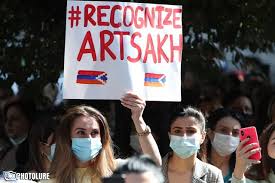
A month has passed since the outbreak of large-scale hostilities between Armenia and Azerbaijan. Although three ceasefires were announced to be put into effect on 10, 18, and 26 October, they did not hold and the clashes thus continue. At the same time, a propaganda war ensues between the two sides. Whereas Azerbaijan seems to have the upper hand on the battlefield, Armenia seems more triumphant in the propaganda sphere. Armenian diasporic communities in Western countries once again proved to be an important asset in this sphere. For now, the diplomatic field is relatively dormant, although the OSCE Minsk Group co-chair countries, namely, Russia, the US, and France appear to be trying to broker a ceasefire.
There are signs of the opening of a new front. Few days after the launch of the campaign for the recognition of the de facto entity in Karabakh under the hashtag #RecogniseArtsakh, officials of Armenia began arguing for the same cause by bringing the doctrine of remedial secession forward. This indicates that the Armenian side attempts to open a new front in the legal sphere. Yet, it is likely that the Armenian side will carry out not a real legal battle, but a lawfare. That is to say, the Armenian side will use legal arguments as another propaganda discourse and try to win a better position in the diplomatic field by forwarding the same sort of arguments. As such, we can expect to see an amalgam of legal arguments, propaganda, and diplomatic maneuvers. We have already witnessed Armenian lobbying targeting local and national governments for the recognition of the de facto entity in Karabakh in the US, France, and some other countries
Remedial secession is a contemporary doctrine prescribing unilateral secession, in other words, unilateral external self-determination, which is a specific form of self-determination. This doctrine has become a matter at hand particularly in academia since the collapse of the Soviet Bloc. Given the indicators that this doctrine will be propagated and hotly debated, it is worth analyzing this doctrine and its applicability to the Karabakh case to see if it can lay the legal grounds of the unilateral secession of the de facto entity in Karabakh and its recognition as an independent state. To do that, first, the concept of self-determination will be outlined from a historical perspective. Following that, the main points of the doctrine of remedial secession will be examined from a legal perspective. Thirdly, practical dilemmas that unilateral external self-determination via this doctrine will be explored to comprehend the applicability of this doctrine. These will provide an understanding on the validity of this doctrine as a legal basis for unilateral self-determination. Upon that background, in the second section of this analysis, which will be published as a follow up to article, the applicability of remedial secession to the Karabakh case will be inspected.
Self-Determination in International Law and Politics
In general terms, self-determination signifies the right of the peoples to decide their own destiny, particularly with respect to deciding how it will be governed. It involves the right to form representative government.[1] Self-determination has two main variants, namely, internal self-determination connoting forms of autonomy within the parent state and external self-determination connoting independence from the parent state.
The concept of self-determination was for the first time used by the then US President Windrow Wilson at the Paris Peace Conference in 1919-1920. Yet, the concept raised question marks as to its practical value. Even the US Secretary of State of the Wilson administration Robert Lansing displayed his suspicion about the concept by stating “the phrase is loaded with dynamite. It will raise hopes that can never be realized.” When the League of Nations was created in 1920, the concept of self-determination was not included in its covenant. This reveals that at that time this concept did not obtain significant support in the international domain.[2] In the same year, the case of the Aaland Islands became the first international legal case, in which a court file on self-determination was tried. Following the end of World War I, the strategically important Aaland Islands inhabited by Swedish speakers and belonging to Finland became disputed between Finland and Sweden. Inhabitants of the islands claimed the right to self-determination and demanded reunification with Sweden. The case was referred to League of Nations. In 1921, the Council of the League of Nations adopted a resolution recognizing Finland's sovereignty over the islands, and, at the same time, recommending autonomy and guarantees for the islands’ population to preserve its language, culture, and local traditions. Eventually, the Aaland Islands case established that if minority rights are fully protected, demands for secession are not justified. As such, this first international legal case established that self-determination did not necessarily amount to right to secession and internal self-determination was legally more privileged than external self-determination.
When United Nations was established in 1945, the concept of self-determination is mentioned in the Article 1 of its charter as; “to develop friendly relations among nations based on respect for the principle of equal rights and self-determination of peoples, and to take other appropriate measures to strengthen universal peace.” Likewise, Article 55 also mentions the same concept. This was the first time that self-determination was indicated in, hence recognized by, an international document. However, it remains as a concept, which is not sufficiently elaborated and that lacks practical value. It failed to evolve into a right and remained as a principle.[3] Self-determination in the UN Charter principally connotes rights about autonomy within the framework drawn by the principle of territorial integrity instead of secession.
The end of World War II opened up the era of decolonization that spanned over approximately twenty-five years between 1945 and 1970. At that period, self-determination became a highly discussed concept and it, in specific, external self-determination, was establishment as a right. Yet, the colonial context and decolonization drew the boundaries of that right; external self-determination was recognized as a right of the colonial subjects vis-à-vis the colonial powers and of those peoples subjected to ‘alien subjugation.’[4] Overall, the era of decolonization brought with it the right of external self-determination, though within a specific historical context, i.e., colonialism. Because of this contextual framework, by the closing of the era of colonialism, external self-determination fell off the agenda for practically turning into a behind the time right.
Finally, the collapse of the Soviet Bloc and the end of the Cold War opened a new era that once again brought the question of self-determination into the agenda. The rise of concerns over human rights and democratization as well as the international human rights law in the post-Cold War era preconditioned the rising interest in the concept of self-determination and its different modalities. In general, self-determination began to be viewed as a major remedy to human rights abuses, oppression, and violation of political, cultural, and other rights. Accordingly, both internal self-determination and external self-determination gained currency in academic writing and the political domain. Within this framework, the doctrine of remedial secession as a modality of external self-determination became a topic of discussion, particularly among academic circles.
The Doctrine of Remedial Secession
Basically, remedial secession is a doctrine that envisages that if a specific people living in the territory of a state is not adequately represented within the polity of that state and the (human) rights of this group are being violated, that state may not benefit from the principle of territorial integrity. Subsequently, external self-determination of the oppressed group, that is, the secession of that group from the parent state, may come into question as a remedy to the violations that the group is subjected to. As such, as said above, the doctrine of remedial secession lays the theoretical-legal basis of unilateral external self-determination as a specific form of self-determination.
It should be underlined that, just like the establishment of external self-determination as a right in the colonial context, the doctrine of remedial secession is an era-specific doctrine and as such reflects the hegemonic ideological-political principles of the post-Cold War era. Therefore, external self-determination via remedial secession in the post-Cold War era should not be equated with the right of external self-determination endowed to colonial subjects in the colonial era, and it ought to be studied in its own specificity.
High threshold
The first important point to note about remedial secession is that whereas colonial status was the satisfactory reason that unequivocally gave colonial subjects the right to external self-determination, not each and every instance of human rights abuses and absence of representation of a specific people automatically validates external self-determination. Rather, only mass, systematic, and gross human rights abuses and other violations may bring remedial secession in as a probability.
Last resort
It should also be underlined that that whereas external self-determination in the colonial context is commonly accepted as a primal remedy, remedial secession is identified only as the last resort - an ultimum remedium. This means that remedial secession may be applied only after all the other possible remedies are exhausted and only when no other alternative is left out to bring an end to the mass, systematic, and gross violations with respect to human rights and representation.
Primacy of internal self-determination
The axiom that outside the colonial context, remedial secession is only a last resort also indicates the primacy of other remedies. In this respect, in the post-Cold War era, internal self-determination has precedence over external self-determination. Only in case of the continuity of violations and the impossibility of their remedy through internal self-determination does external self-determination become an option.
The judgement of the Supreme Court of Canada in the Quebec case in 1998, which is regarded as the most authoritative judicial verdict with respect to the doctrine of remedial secession, clearly demonstrates this fact. In its judgement on the Quebec case, the Canadian court confirmed not only that unilateral secession is not a right in international law, it also established that internal self-determination is the norm in international law. As to that, the Court stated the following:
“The recognized sources of international law establish that the right to self-determination of a people is normally fulfilled through internal self-determination - a people’s pursuit of its political, economic, social and cultural development within a framework of an existing state. A right to external self determination (which in this case potentially takes the form of the assertion of a right to unilateral secession) arises in only the most extreme of cases and, even then, under carefully defined circumstances.”[5]
Legal ways
Last but not least, another important aspect of external self-determination via remedial secession is that it cannot be achieved through methods that breach international law. In other words, external self-determination cannot be a result of illegal actions such as unlawful armed uprising or terrorism. This is, in fact, an application of the principle of ex injuria jus non oritur (law/right does not arise from injustice; unjust acts cannot create law/right). In brief, the method and the process of unilateral secession are decisive with respect to the legality of the consequent political entity. This crucial point is underlined by the International Court of Justice (ICJ) in its judgement on the Kosovo case, which affirmed that although unilateral secession per se is not illegal, secession is illegal if it is a result of “unlawful use of force or other egregious violations of norms of general international law, in particular those of a peremptory character (jus cogens).”[6]
Dilemmas of the Doctrine of Remedial Secession
The doctrine of remedial secession is a topic that is discussed particularly in the academic literature. Although this doctrine has some support in academia, most of the legal scholars are skeptical about this doctrine. The common understanding is that remedial secession is an uncertain doctrine that cannot lay the grounds of a legal right for unilateral external self-determination. It is commonly believed that unilateral external self-determination via remedial secession is neither a legal right nor illegal, and as such is an ambiguous concept. Likewise, scholars are also skeptical about the practical results of the application of remedial secession, as they believe unilateral external self-determination via remedial secession would cause more practical problems than it solves.
A principle by reverse reading
One of the main reasons why unilateral external self-determination via remedial secession is surrounded by ambiguity is that there is no international document that directly and openly identifies it as a right. On the contrary, only reverse reading of international documents hints at the possibility of unilateral external self-determination.
The relevant international documents justify sovereign rights and territorial integrity of the states provided that their governments represent their entire population without discrimination, ensure minorities the conditions to preserve their language, culture and to maintain their identity, and respect human rights. Only the reverse reading of this conditionality brings up the possibility of deprivation of the states that do not fulfill these conditions from the sovereign rights and territorial integrity.
The 1970 Declaration on Principles of International Law concerning Friendly Relations and Co-operation among States in accordance with the Charter of the United Nations (Friendly Relations Declaration) is regarded as the international document that draws nearest to the defense of unilateral external self-determination. Therefore, this document could be taken as an example to understand this method of interpretation.
The fifth principle in this document, namely, “The principle of equal rights and self-determination of peoples,” partially reads as follows:
By virtue of the principle of equal rights and self-determination of peoples enshrined in the Charter of the United Nations, all peoples have the right freely to determine, without external interference, their political status and to pursue their economic, social and cultural development, and every State has the duty to respect this right in accordance with the provisions of the Charter.
Every State has the duty to promote, through joint and separate action, realization of the principle of equal rights and self-determination of peoples, in accordance with the provisions of the Charter, and to render assistance to the United Nations in carrying out the responsibilities entrusted to it by the Charter regarding the implementation of the principle, in order:
(a) To promote friendly relations and co-operation among States; and
(b) To bring a speedy end to colonialism, having due regard to the freely expressed will of the peoples concerned (emphasis added).
The same principle also states:
Nothing in the foregoing paragraphs shall be construed as authorizing or encouraging any action which would dismember or impair, totally or in part, the territorial integrity or political unity of sovereign and independent States conducting themselves in compliance with the principle of equal rights and self-determination of peoples as described above and thus possessed of a government representing the whole people belonging to the territory without distinction as to race, creed or colour.
Every State shall refrain from any action aimed at the partial or total disruption of the national unity and territorial integrity of any other State or country.
As can be seen, Friendly Relations Declaration brings up self-determination for colonial subjects. At the same time, it endows territorial integrity to those states, which comply with the principle of equal rights and self-determination of peoples and possess governments that represent all the population without discrimination. This reveals that the document makes a categorical distinction between colonial and non-colonial settings, and implies internal self-determination for the latter. Only through the reverse reading of this document, it can be interpreted that in non-colonial settings, only when a state discriminates against a certain section of its population, can external self-determination become an option.
Contradiction between the principles of sovereignty and territorial integrity, and unilateral external self-determination
One of the reasons why there is a significant hesitance about remedial secession is its likely detrimental consequences on the international system. First, unilateral external self-determination is in direct contradiction with the international law principles of state sovereignty and territorial integrity. Certainly, this was also the case during the colonial era. Yet, the difference is that external self-determination of the colonial subjects from the metropolitan states does not breach sovereignty and territorial integrity of the latter. For example, the decolonization of the French colonies in Africa or elsewhere did not result in the shattering of the territorial integrity of the French homeland in Europe. Therefore, decolonization via external self-determination does not cause a contradiction in international law. In the post-colonial era, however, remedial secession inevitably contradicts with the principles of sovereignty and territorial integrity.
As to this contradiction, it should be noted that, despite the rise of the hegemony of international human rights law at the expense of the supremacy of the principles of sovereignty and territorial integrity, these two principles are still regarded as more privileged than the principle of self-determination. Besides that, as mentioned above, internal self-determination is the primary version of self-determination. The higher status of international self-determination resolves the discord between the principles of territorial integrity and self-determination, and to a lesser extend between the latter and the principle of state sovereignty.
Sustainability of the international system and peace
Related to that contradiction, remedial secession is also a controversial doctrine from a political-practical point of view with respect to interstate relations, global peace, and sustainability of the international system. Marc Weller, in a study published in 2009, notes that there are about twenty-six active armed self-determination conflicts around the world with varying intensities. In addition, there are about fifty-five campaigns for self-determination carrying the potential to turn into armed conflicts. Fifteen self-determination conflicts are temporarily settled, yet carry the risk of reigniting.[7]
These figures reveal why external self-determination via remedial secession poses a risk to the international system; if external self-determination becomes a right and a norm, then the borders of almost half of the existing states would change and the number of the existing states would increase by a half. Obviously, international system would not hold against such a big upheaval. As to this point, what former UN Secretary-General Boutros Boutros-Ghali wrote in his Agenda for Peace is an important reminder:[8]
Yet if every ethnic, religious or linguistic group claimed statehood, there would be no limit to fragmentation, and peace and security and economic wellbeing for all would become ever more difficult to achieve. The sovereignty, territorial integrity and independence of States within the established international system, and the principle of self-determination for peoples, both of great value and importance, must not be permitted to work against each other in the period ahead.
What is also evident is that if remedial secession becomes a right and a norm, it may turn into a factor triggering radical secessionist organizations to flourish and may encourage them to adopt violent methods. Such a possibility would increase the risk of persecution of the minorities and lower the chances of peaceful secession or solutions through internal self-determination. In addition, third actors such as regional powers and irredentist states may agitate secessionist movements and instrumentalize self-determination conflicts for their own objectives.[9] Such a possibility would obviously push interstate relations into a chaotic state and open up the prospect of increasing proxy wars via secessionist movements. The emphasis on the illegality of the influence involvement of third parties in self-determination processes in Helsinki Final Act, which is quoted below, could be taken as a warning to that possibility.
By virtue of the principle of equal rights and self-determination of peoples, all peoples always have the right, in full freedom, to determine, when and as they wish, their internal and external political status, without external interference, and to pursue as they wish their political, economic, social and cultural development (emphasis added).[10]
Principle without practice
Between 1946 and 1960, in Asia and Africa, three dozen new states gained autonomy or complete independence from their European colonial rulers.[11] Since the creation of the United Nations in 1945, a total of eighty former colonies have gained their independence. Whereas in 1945 about 750 million people, a number that amounted to a third of the world’s population lived under colonial rule, today this number declined to less than 2 million living in seventeen territories that still waits to be decolonized.[12]
With the collapse of the Soviet Bloc, more than twenty new states appeared from the ruins of the Union of Soviet Socialist Republics (USSR), Socialist Federal Republic of Yugoslavia (SFRY), and Czechoslovakia. Yet, the independence of the former republics of the USSR, including the three Baltic states, was a result of a consensual act rather than unilateral secession. Likewise, disintegration of Czechoslovakia into Czechia and Slovakia was a result of a consensus.
In the case of SFRY, Slovenia and especially Croatia made claims using the language of the doctrine of remedial secession when they declared independence from the SFRY. The independence of these two countries was not a result of a consensual act either. Yet, because their independence was preceded by the dissolution of the SFRY, legally speaking, there were no competing territorial claims between these countries and another state. Therefore, Slovenia and Croatia do not constitute an example of the application of the doctrine of remedial secession.[13]
In stark contrast to the era of decolonization, since 1991, there has been only one case of external self-determination via unilateral independence without the consent of the parent state. This is the Kosovo case. Yet, it should be highlighted that so far Kosovo’s independence gained only partial recognition by the international community. Accordingly, it is apparent that remedial secession is not a doctrine that is being practiced in the international domain. In fact, the aforementioned political-practical dilemmas are probably the reasons why there has been only the Kosovo case as the sole, though incomplete, example of unilateral secession since 1991.
The Kosovo case
Still, the Kosovo case may be brought forward as an example of the validity of remedial secession. Therefore, it may be necessary to briefly elaborate on this case. The first thing that should be underlined is that in 2008 the United Nations General Assembly requested an advisory opinion from the International Court of Justice regarding the accord of Kosovo’s unilateral declaration of independence with international law. In its majority opinion, the Court refrained from addressing the issue of remedial secession by stating,
As the Court has already noted (see paragraphs 49 to 56 above), and as almost all participants agreed, that issue is beyond the scope of the question posed by the General Assembly. To answer that question, the Court need only determine whether the declaration of independence violated either general international law or the lex specialis created by Security Council resolution 1244 (1999).[14]
The Court judged that Kosovo’s declaration of independence was not a violation of international law because the latter did not have any “applicable prohibition of declarations of independence.”[15] Accordingly, no opinion was declared about the doctrine of remedial secession. This means that Court’s judgment about the independence of Kosovo did not rest on this doctrine. It should also be noted that three judges issued their opinions on remedial secession; two in favor and one against.[16]
It should also be underscored that thirty-six states tendered country submissions to the Court. Eleven of them averred that remedial secession was an established international law that is applicable in certain cases; six declared different views on remedial secession and claimed Kosovo case was a sui generis case; five states remained neutral or ambiguous on remedial secession; and fourteen states rejected the idea that remedial secession was an established international law.[17] As of March 2020, 92 United Nations member states out of 193 recognize the independence of Kosovo. This is less than half, more accurately 48%, of the UN member states. Kosovo has still not been granted UN membership. Since its declaration of independence in 2008, eighteen states, which formerly recognized Kosovo’s independence, has withdrawn their recognition. These display that Kosovo is far from being an established positive example for the unilateral external self-determination, which may serve as an example of other secessionist entities. Overall, the Kosovo case does not constitute a case law about the remedial secession.
Uncertain and unapplied international law principle
Overall, both theoretical-academic debates and the practice reveal that remedial secession as a modality of unilateral external self-determination is at best a soft law, meaning a principle that is not legally binding, or “whose binding force is somewhat ‘weaker’ than that of traditional law”[18] as opposed to hard law, that is, “legal obligations that are binding on the parties involved and which can be legally enforced before a court.”[19] The fact that only eleven states affirmed remedial secession as an established international law and less than half of the UN member states recognized the independence of Kosovo displays that it is still far from becoming a general customary international law and accordingly becoming a positive law. At the present, there is no single flawless example of the application of remedial secession that resulted in the creation of a non-colonial new state.[20]
Interim Conclusion: The Validity of the Doctrine of Remedial Secession as a Basis for Unilateral Self-Determination
In general terms, remedial secession is a doctrine that advocates unilateral secession, as opposed to internal self-determination, consensual secession, or secession as a result of the dissolution of the parent state. It is a last resort solution that is to be implemented after the exhaustion of all other possible remedies to mass, systematic, and gross human rights abuses and other violations, perpetrated by a state against a specific people, which is a part of its population. Unilateral self-determination via remedial secession cannot be a result of actions such as terrorism or the interference of another state that violate international law. It is an era-specific doctrine that gained attention after the fall of the Soviet Bloc contingent to the rise of international human rights law in that same era. As such, unilateral secession via remedial secession is a categorically different phenomenon from external self-determination in the colonial context. Therefore, decolonization cannot epitomize unilateral secession via remedial secession.
At the present, self-determination is an established right and practice. However, its scope is uncertain and what has been the topic of discussion is that scope. The common understanding is that internal self-determination is a right, whereas unilateral external self-determination is only a principle, theoretical and practical aspects of which are still a matter of debate. Accordingly, the commonly agreed scope of self-determination is internal self-determination. The little support that unilateral external self-determination has gained basically comes from the participants of academic-theoretical debates.
Although the theoretical foundations of remedial secession were laid by the Aaland Islands case in 1920, it still lacks a solid legal-theoretical basis. First, it is in direct contradiction with the principles of sovereignty and territorial integrity, which have a higher status than the principle of self-determination in international law, even if the rise of international human rights law erodes their absoluteness. Second, there is no international document that directly and openly justifies unilateral external self-determination as a right or principle. Only through the reverse reading could this idea be found in international documents. Accordingly, there is not enough indication that remedial secession is a universally accepted right of oppressed peoples. Likewise, in international legal doctrine, there is nothing that indicates states have an obligation to recognize secessionist entities.
There is no practice of unilateral external self-determination via remedial secession. The only partially successful case of Kosovo does not constitute a case law for remedial secession. The emergence of independent states following the collapse of the Soviet Bloc is the results of dissolution of the parent state and consensual secession. As such, they do not constitute examples for remedial secession. As a result, there is no international customary law about the right of unilateral external self-determination via remedial secession.
It is obvious that the implementation of the doctrine of remedial secession is prone to create more problems than it solves. Remedial secession would become a tool for irredentist states or those which seek dominance by weakening other states. Even in the absence of third parties, establishment of this doctrine as a right and a norm would result in further conflicts between the governments and peoples. Even if remedial secession is advocated in good faith to overcome human rights violations, proponents of this doctrine fail to address the quite likely challenges of remedial secession to interstate relations, peace, and international order.
All these points should be sufficient to demonstrate that the doctrine of remedial secession as a basis for unilateral self-determination is highly controversial both theoretically and practically, and has, at best, little validity. Taking these into consideration, the more constructive way to secure the rights of minority groups would be to search for ways to strengthen democracy and constitutional citizenship of the countries they live in. If that cannot be achieved because of the inconformity of the government, internal self-determination is the valid and politically sounder option with a more solid legal basis and wider practice.
* Photo: Aravot
[1] “Self-Determination,” Cambridge Dictionary, access October 26, 2020, https://dictionary.cambridge.org/dictionary/english/self-determination; “Self determination (international law),” Cornell Law School Legal Information Institute, access October 26, 2020, https://www.law.cornell.edu/wex/self_determination_(international_law)#:~:text=Self%2Ddetermination%20denotes%20the%20legal,a%20number%20of%20international%20treaties; Milena Sterio, “Self-Determination and Secession Under International Law: The Cases of Kurdistan and Catalonia,” American Society of International Law 22, no. 1 (2018), access October 26, 2020, https://www.asil.org/insights/volume/22/issue/1/self-determination-and-secession-under-international-law-cases-kurdistan
[2] Sopio Asatiani, Remedial Secession under International Law: analysis of Kosovo, Abkhazia and South Ossetia (LL.M. Human Rights Thesis, Central European University, 2013), 7, access October 26, 2020, https://blogs.elpais.com/files/remedial-secession-asatiani_sopio.pdf.
[3] Mia Abel, “Is There a Right to Secession in International Law?” E-International Relations, May 18, 2020, access October 26, 2020, https://www.e-ir.info/2020/05/18/is-there-a-right-to-secession-in-international-law/.
[4] Asatiani, Remedial Secession under International Law: analysis of Kosovo, Abkhazia and South Ossetia Asatiani, 36-37.
[5] Jure Vidmar, “Remedial Secession in International Law: Theory and (Lack of) Practice,” St Antony’s International Review 6, no. 1 (2010), 39.
[6] Lina Laurinavičiūtėn and Laurynas Biekša, “The Relevance of Remedial Secession in the Post-Soviet ‘Frozen Conflicts’,” International Comparative Jurisprudence 1 (2015), 68.
[7] Marc Weller, “Settling Self-determination Conflicts: Recent Developments,” The European Journal of International Law 20, no. 1 (2009), 112, access October 26, 2020, http://www.ejil.org/pdfs/20/1/1788.pdf.
[8] Boutros Boutros-Ghali, Agenda for Peace (1992), access October 26, 2020, https://www.un.org/ga/search/view_doc.asp?symbol=A/47/277.
[9] Daniel H. Meester, “Remedial Secession: A Positive or Negative Force for the Prevention and Reduction of Armed Conflict?” Canadian Foreign Policy Journal 18, no. 2 (2012), 156.
[10] Conference on Security and Co-operation in Europe Final Act (Helsink, 1975), access October 26, 2020, https://www.osce.org/files/f/documents/5/c/39501.pdf.
[11] “Decolonization of Asia and Africa, 1945–1960,” Office of the historian Department of State of the United States of America, access October 26, 2020, https://history.state.gov/milestones/1945-1952/asia-and-africa#:~:text=Between%201945%20and%201960%2C%20three,from%20their%20European%20colonial%20rulers.
[12] “Decolonization,” United Nations, access October 26, 2020, https://www.un.org/en/sections/issues-depth/decolonization/.
[13] Jure Vidmar, “Remedial Secession in International Law: Theory and (Lack of) Practice,” 45-47.
[14] Accordance with International Law of the Unilateral Declaration of Independence in Respect of Kosovo, Advisory Opinion, I.C.J. Reports 2010, par. 83.
[15] Lina Laurinavičiūtėn and Laurynas Biekša, “The Relevance of Remedial Secession in the Post-Soviet ‘Frozen Conflicts’,” 68
[16] Daniel H. Meester, “Remedial Secession: A Positive or Negative Force for the Prevention and Reduction of Armed Conflict?” Canadian Foreign Policy Journal 18, no. 2 (2012), 153.
[17] Daniel H. Meester, “The International Court of Justice’s Kosovo Case: Assessing the Current State of International Legal Opinion on Remedial Secession,” in The Canadian Yearbook of International Law 2010, ed. J.H. Currie (Vancouver, BC: UBC Press, 2011), 223-243.
[18] “Soft Law,” OECD, access October 26, 2020, https://www.oecd.org/gov/regulatory-policy/irc10.htm.
[19] “Hard Law/Soft Law,” ECCHR, access October 26, 2020, https://www.ecchr.eu/en/glossary/hard-law-soft-law/.
[20] Jure Vidmar, “Remedial Secession in International Law: Theory and (Lack of) Practice,” 51.
© 2009-2025 Center for Eurasian Studies (AVİM) All Rights Reserved
No comments yet.
-
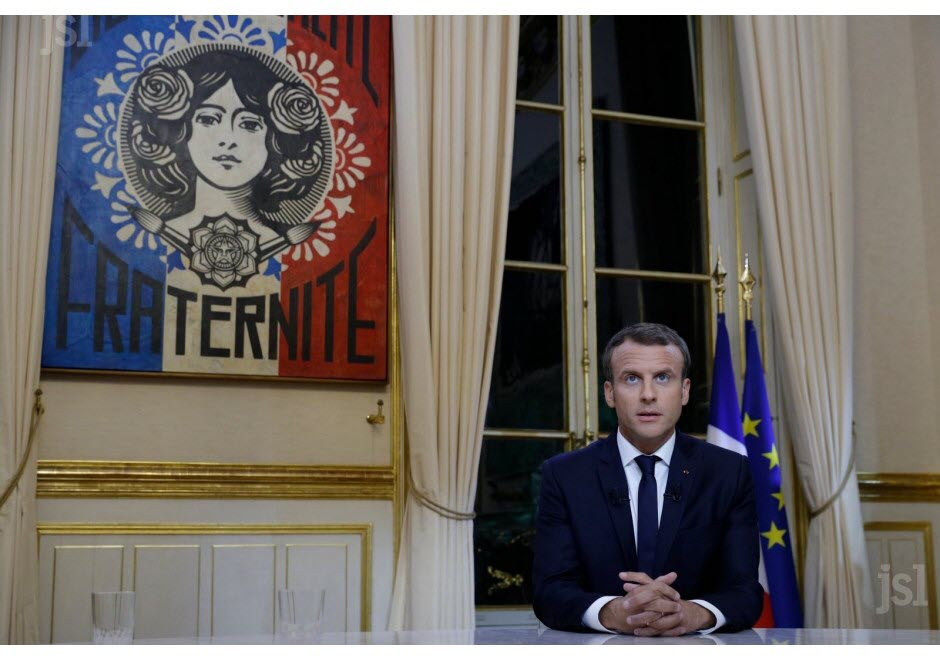 THE FIGHT OF FRANCE AGAINST FRANCE AND THE FUTURE OF EUROPE
THE FIGHT OF FRANCE AGAINST FRANCE AND THE FUTURE OF EUROPE
Turgut Kerem TUNCEL 22.02.2019 -
 BECOMING THE PART OF THE PROBLEM: THE FAULTY POLICIES OF THE WEST IN EURASIA AND THE SOUTH CAUCASUS
BECOMING THE PART OF THE PROBLEM: THE FAULTY POLICIES OF THE WEST IN EURASIA AND THE SOUTH CAUCASUS
Turgut Kerem TUNCEL 11.08.2015 -
 AN INQUIRY INTO NANCY PELOSI’S VISIT TO ARMENIA
AN INQUIRY INTO NANCY PELOSI’S VISIT TO ARMENIA
Turgut Kerem TUNCEL 23.09.2022 -
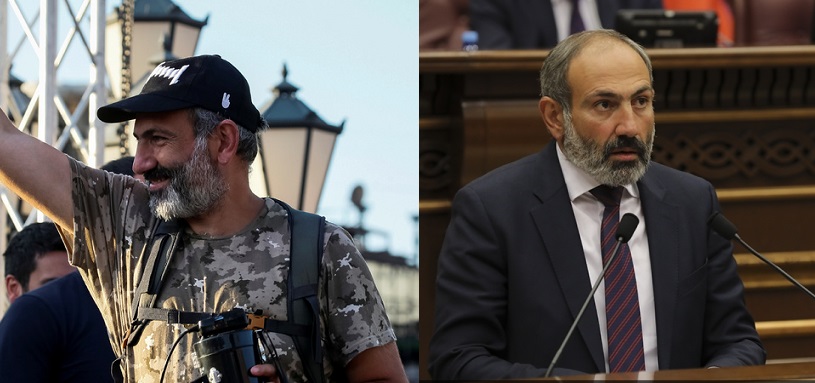 AN ANALYSIS OF THE POLITICS IN ARMENIA AFTER THE “VELVET REVOLUTION”
AN ANALYSIS OF THE POLITICS IN ARMENIA AFTER THE “VELVET REVOLUTION”
Turgut Kerem TUNCEL 01.06.2018 -
 EUROPEAN PARLIAMENT RESOLUTION OF 15 APRIL 2015 ON THE CENTENARY OF THE ARMENIAN GENOCIDE
EUROPEAN PARLIAMENT RESOLUTION OF 15 APRIL 2015 ON THE CENTENARY OF THE ARMENIAN GENOCIDE
Turgut Kerem TUNCEL 21.04.2015
-
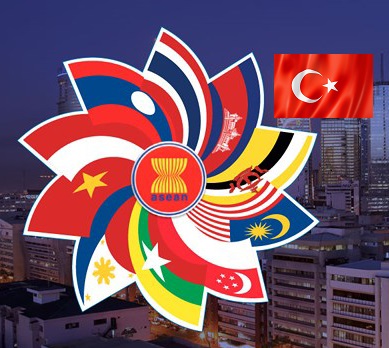 PROSPECTS FOR EXPANDING TURKEY-ASEAN RELATIONS
PROSPECTS FOR EXPANDING TURKEY-ASEAN RELATIONS
Teoman Ertuğrul TULUN 10.08.2018 -
 THE NEW SILK ROAD INITIATIVE: TURKEY’S STAKES IN THE GLOBAL DEVELOPMENTAL PROJECT
THE NEW SILK ROAD INITIATIVE: TURKEY’S STAKES IN THE GLOBAL DEVELOPMENTAL PROJECT
S. Işık BORA 07.08.2017 -
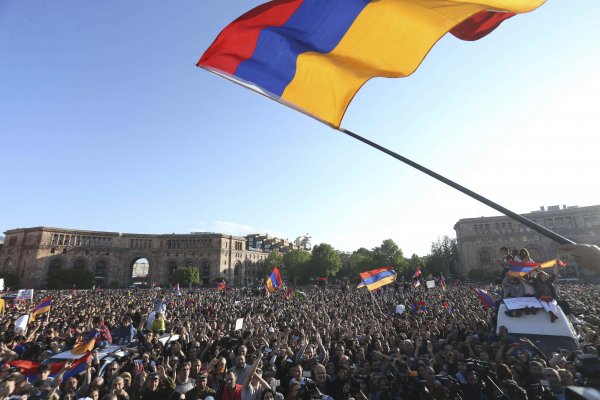 THE RULE STARTED WITH DEMONSTRATIONS ENDED WITH DEMONSTRATIONS
THE RULE STARTED WITH DEMONSTRATIONS ENDED WITH DEMONSTRATIONS
Tutku DİLAVER 14.05.2018 -
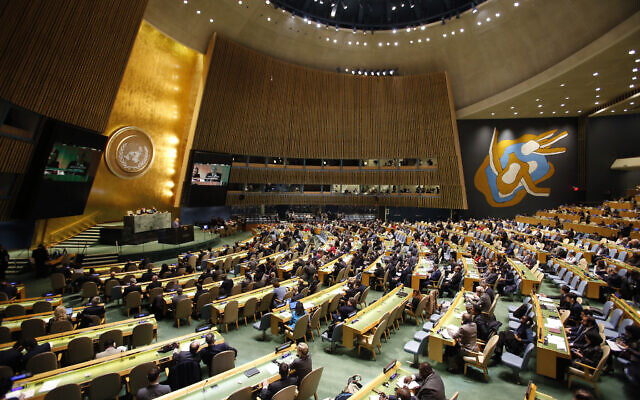 THE UN GENERAL ASSEMBLY REJECTED AND CONDEMNED HOLOCAUST DENIAL AND RECALLED THE INTERNATIONAL LEGAL BASIS OF ITS REJECTION
THE UN GENERAL ASSEMBLY REJECTED AND CONDEMNED HOLOCAUST DENIAL AND RECALLED THE INTERNATIONAL LEGAL BASIS OF ITS REJECTION
Teoman Ertuğrul TULUN 04.02.2022 -
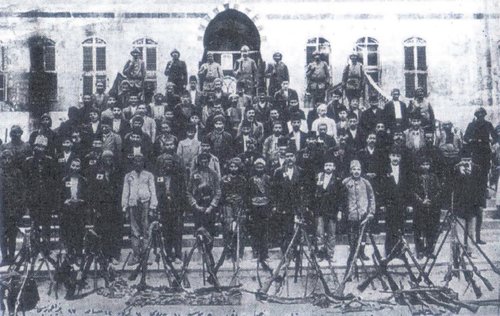 24 APRIL 1915: WHAT HAPPENED?
24 APRIL 1915: WHAT HAPPENED?
Tutku DİLAVER 27.04.2018
-
25.01.2016
THE ARMENIAN QUESTION - BASIC KNOWLEDGE AND DOCUMENTATION -
12.06.2024
THE TRUTH WILL OUT -
27.03.2023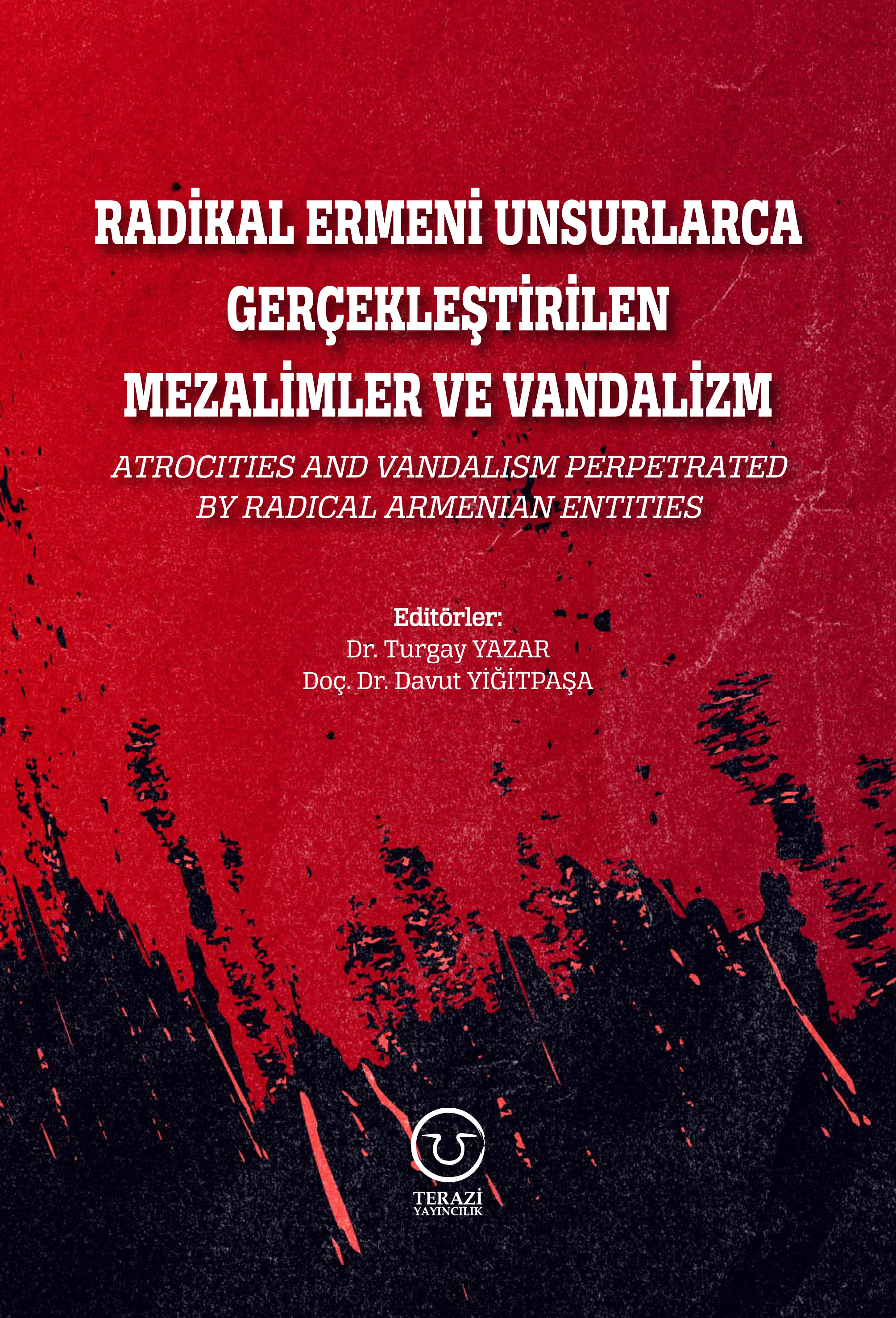
RADİKAL ERMENİ UNSURLARCA GERÇEKLEŞTİRİLEN MEZALİMLER VE VANDALİZM -
17.03.2023
PATRIOTISM PERVERTED -
23.02.2023
MEN ARE LIKE THAT -
03.02.2023
BAKÜ-TİFLİS-CEYHAN BORU HATTININ YAŞANAN TARİHİ -
16.12.2022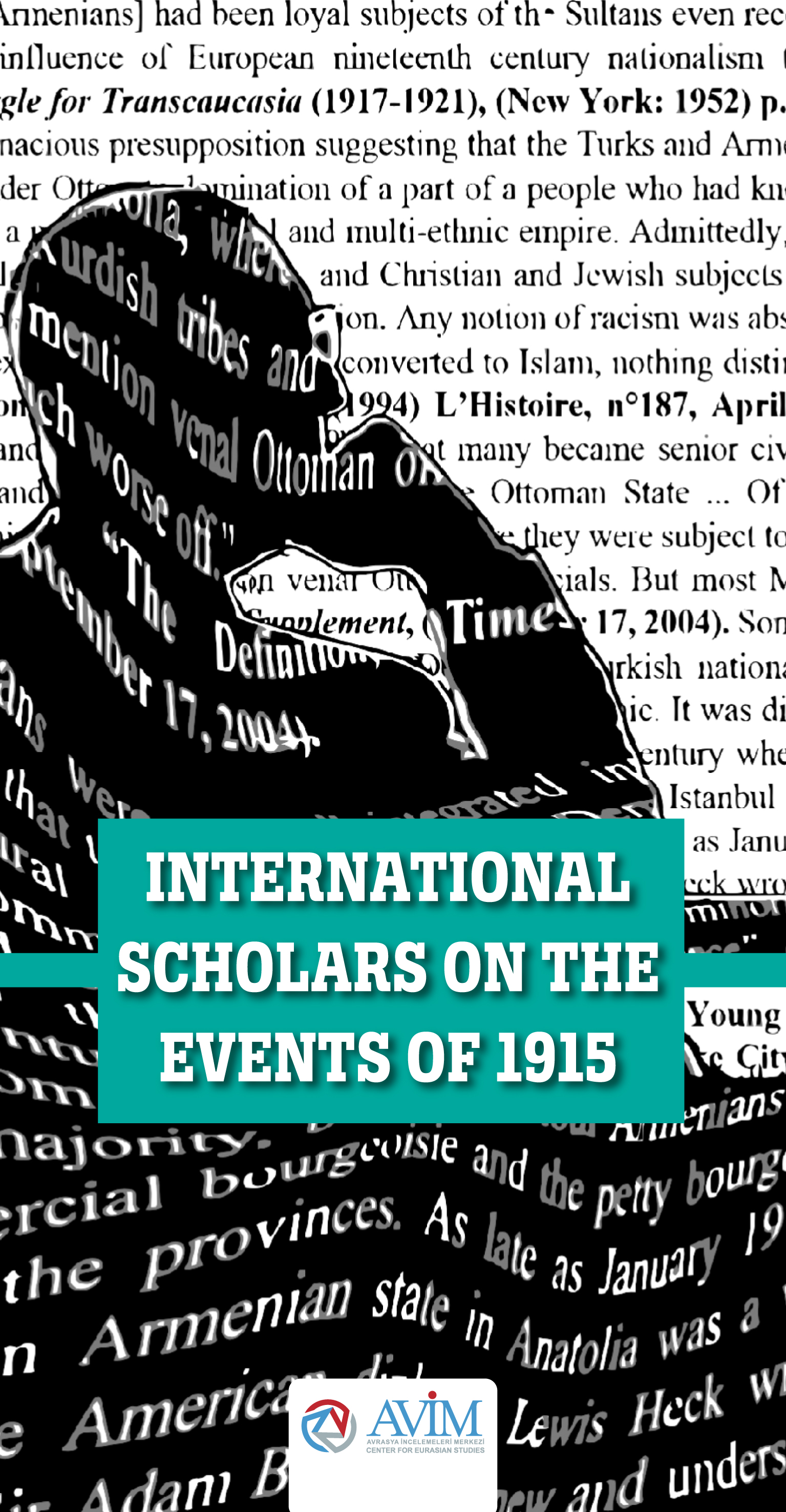
INTERNATIONAL SCHOLARS ON THE EVENTS OF 1915 -
07.12.2022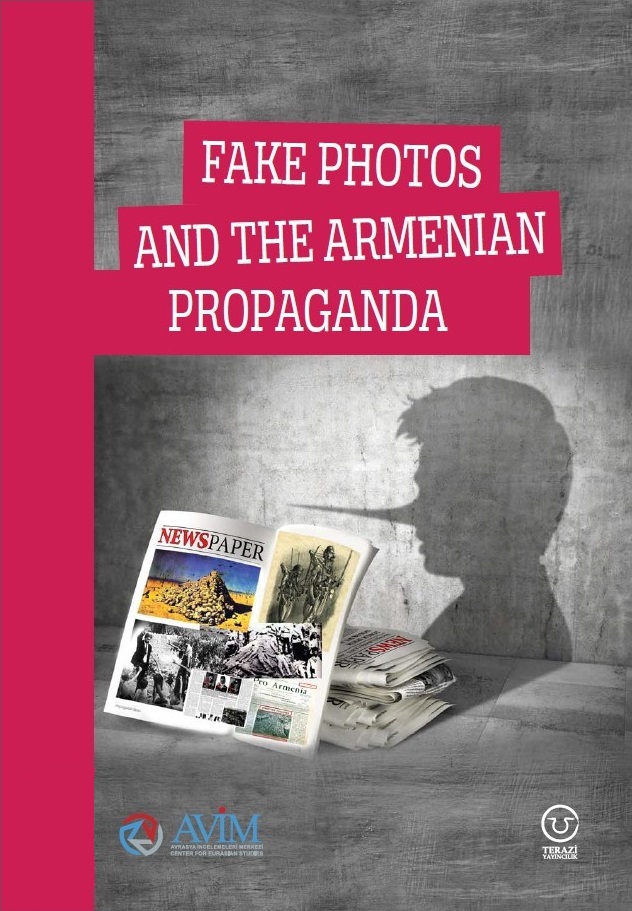
FAKE PHOTOS AND THE ARMENIAN PROPAGANDA -
07.12.2022
ERMENİ PROPAGANDASI VE SAHTE RESİMLER -
01.01.2022
A Letter From Japan - Strategically Mum: The Silence of the Armenians -
01.01.2022
Japonya'dan Bir Mektup - Stratejik Suskunluk: Ermenilerin Sessizliği -
03.06.2020
Anastas Mikoyan: Confessions of an Armenian Bolshevik -
08.04.2020
Sovyet Sonrası Ukrayna’da Devlet, Toplum ve Siyaset - Değişen Dinamikler, Dönüşen Kimlikler -
12.06.2018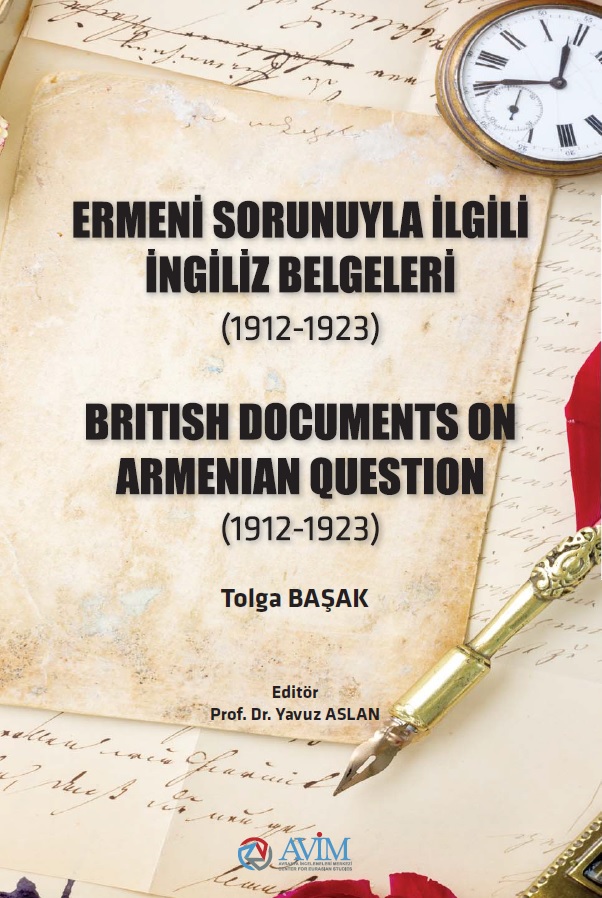
Ermeni Sorunuyla İlgili İngiliz Belgeleri (1912-1923) - British Documents on Armenian Question (1912-1923) -
02.12.2016
Turkish-Russian Academics: A Historical Study on the Caucasus -
01.07.2016
Gürcistan'daki Müslüman Topluluklar: Azınlık Hakları, Kimlik, Siyaset -
10.03.2016
Armenian Diaspora: Diaspora, State and the Imagination of the Republic of Armenia -
24.01.2016
ERMENİ SORUNU - TEMEL BİLGİ VE BELGELER (2. BASKI)
-
AVİM Conference Hall 24.01.2023
CONFERENCE TITLED “HUNGARY’S PERSPECTIVES ON THE TURKIC WORLD"









